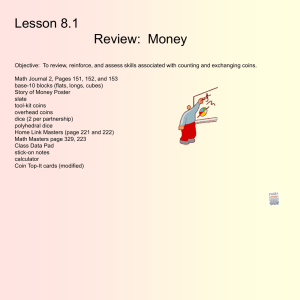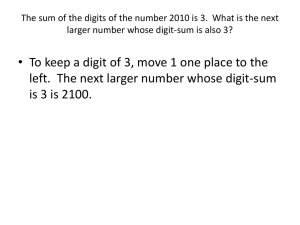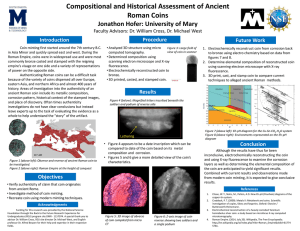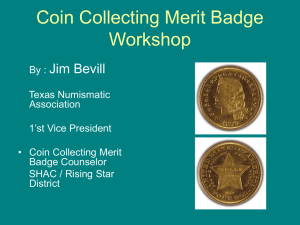Early Roman Coins
advertisement
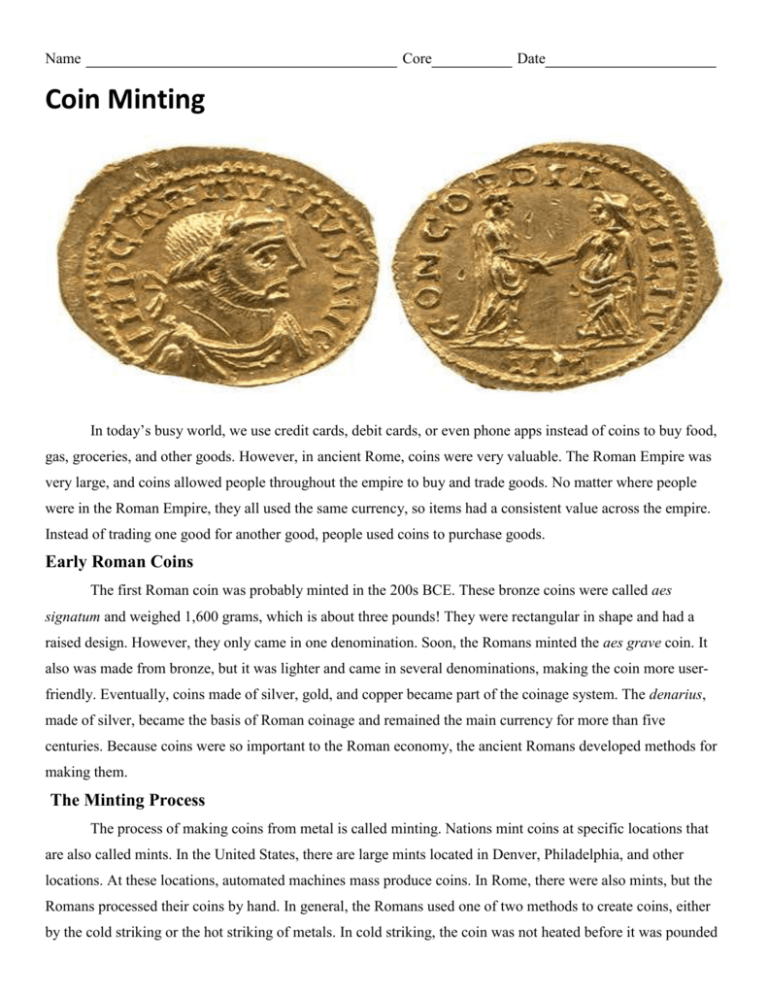
Name _______________________________ Core________ Date_________________ Coin Minting In today’s busy world, we use credit cards, debit cards, or even phone apps instead of coins to buy food, gas, groceries, and other goods. However, in ancient Rome, coins were very valuable. The Roman Empire was very large, and coins allowed people throughout the empire to buy and trade goods. No matter where people were in the Roman Empire, they all used the same currency, so items had a consistent value across the empire. Instead of trading one good for another good, people used coins to purchase goods. Early Roman Coins The first Roman coin was probably minted in the 200s BCE. These bronze coins were called aes signatum and weighed 1,600 grams, which is about three pounds! They were rectangular in shape and had a raised design. However, they only came in one denomination. Soon, the Romans minted the aes grave coin. It also was made from bronze, but it was lighter and came in several denominations, making the coin more userfriendly. Eventually, coins made of silver, gold, and copper became part of the coinage system. The denarius, made of silver, became the basis of Roman coinage and remained the main currency for more than five centuries. Because coins were so important to the Roman economy, the ancient Romans developed methods for making them. The Minting Process The process of making coins from metal is called minting. Nations mint coins at specific locations that are also called mints. In the United States, there are large mints located in Denver, Philadelphia, and other locations. At these locations, automated machines mass produce coins. In Rome, there were also mints, but the Romans processed their coins by hand. In general, the Romans used one of two methods to create coins, either by the cold striking or the hot striking of metals. In cold striking, the coin was not heated before it was pounded into shape. In hot striking, the coin was heated before it was struck. The process began with the arrival of the metal at the mint. Mints during the Roman Empire were often more like blacksmith shops than factories. In a blacksmith shop, metal is heated in a hot fire or furnace before being pounded or poured into shape. Roman coin makers used a similar process. In the first step of The coin-making process, servants and other low-paid workers would heat the metal and melt it or roll it into a sheet. If they melted the metal, they would pour it into a mold to create the shape. If they used sheets, they would stamp the metal sheet into rounded shapes that were blank on both sides. At this first step of metalworking, the workers used tools such as tongs to hold the hot metal sheets and an anvil and hammer to flatten the sheets. An anvil is a heavy metal block. The metal coin sheets were placed on the anvil and they could then be pounded into shape. Using Dies During the second step of the coin-making process, the workers used dies to impress an image onto the flattened, blank disks. Dies were like heavy stamps made out of bronze or iron and were engraved with the coin face. Because the coins of Rome were consistent in look, they may have been made using a soft metal. A soft metal would be easily stamped and all coins would show the same image. The standardized portrait of the people on the coin would be identical from coin to coin, as opposed to the great variation that came from individually engraving each coin. Roman dies were easier to use than Greek dies. The Greeks relied on the weight of the hammer to impress the image. The Greek coin would often have irregularities due to the uneven hammer strike of the person working. The Romans, however, used a hinged die set. This allowed for the coin to be set into a clamp so the coins were more regular. With a hinged die set, the sheet of metal was placed between two dies that were connected by a hinge. The hinge allowed the dies to open and let a sheet of metal slip between them. Coin makers would then strike a side of the hinged die and the image would be impressed on both sides of the coins in a very uniform manner. The hinged die created a uniform coin faster than the unhinged die. Roman mints were very concerned with efficiency. Roman Teamwork The second step of the Roman coin-making process, impressing the coin with an image, usually required a team of two workers. They began by moving strips of heated sheet metal through the die, hammering it, and then later cutting the metal into smaller pieces. Another method allowed the workers to punch the strips with a stamp that also cut the coin from the metal sheet. One worker would set up the sheet and die, while the other would strike the die with a hammer. It usually would take more than one strike of the hammer to impress the die design onto the metal disk. Once the coin was impressed with the main design – usually a portrait- it was ready for the third and final step. During this phase, the impressed coin would go to another craftsman, who would finish the engraving by hand. Having a master engraver was one way to ensure that the coins all resembled one another. The engraver would add any lettering that was too detailed to go into the die. The engraver would also add features to the portrait such as hair curls and facial lines to detail the coin. The Parts of the Coin Roman coins had four distinct features on the side of the coin showing a face (we call this side “heads”): the portrait, the legend, the headdress, and the bust type. The portrait would be of a Roman emperor or leader, or one of their relatives. The legend around the portrait would tell who the person was and their title. The headdress was usually laurels or helmets. A bare head meant that the portrait was not the emperor but someone lesser in rank, like a prince. The bust type would show the person’s status in society. Battle armor meant that the person was a great leader, while a draped toga showed he was a politician in the Senate. The “tail” side of the coin showed different scenes and images, such as battles, religious messages, or even previous emperors. It also had a legend and the code for the mint. The code would usually identify the city that minted the coin, but not the exact location of the mint. Coin minting in Rome was an artistic trade. It was also a respected trade, because the coins were important to the Roman economy. While today’s mints can produce millions of coins each day in a factory-like setting, the Romans produced coins by hand with a great attention to detail. Ancient Roman coins showed fine craftsmanship and a desire to honor the leaders of the time. __________________________________________________________________________________________ Question (8 points) 1. What did Roman coins convey about Roman society? What kinds of information do coins minted in the United States today convey? Use details from the passage and your prior knowledge to support your answer.



